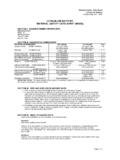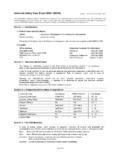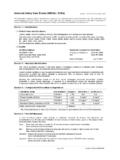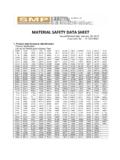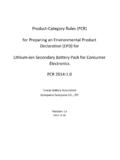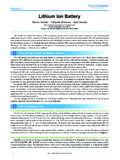Transcription of MATERIAL SAFETY DATA SHEET - Canon Thailand
1 MATERIAL SAFETY data SHEET Page 1 of 5 MSDS#: BA0003-01-090217 Date of Issue: June 29, 2009 Revised Date: - Ver. 2009/6/01 SECTION 1 IDENTIFICATION OF THE SUBSTANCE/MIXTURE AND OF THE COMPANY/UNDERTAKING Product Name: Lithium Ion battery Product Code: LP-E6 Company Name: Canon Inc. Address: 30-2, Shimomaruko 3-Chome, Ohta-ku, Tokyo 146-8501, Japan Use of the Product: battery for Digital camera Supplier: Address: Phone number: SECTION 2 SUBSTANCE IDENTIFICATION Substance: Lithium-Ion rechargeable battery CAS number: Not specified UN Class: Even classified as lithium ion batteries (UN3480), 2009 IATA Dangerous Goods Regulations 50th edition Packing Instruction 965 Part 1 is applied.
2 The product is handled as Non-Dangerous Goods by meeting the following requirements. (1) Par t 1 Lithium ion cells and batteries offered for transport are not subject to other additional requirements of these Regulations if they meet the requirements in Part 1. Lithium batteries identified by the manufacturer as being defective for SAFETY reasons, or that have been damaged, that have the potential of producing a dangerous evolution of heat, fire or short circuit are forbidden for transport ( those being returned to the manufacturer for SAFETY reasons). Lithium ion cells and batteries may be offered for transport if they meet the following: 1.
3 For cells, the Watt-hour rating is not more than 20Wh; 2. for batteries, Watt-hour rating is not more than 100Wh; The Watt-hour rating must be marked on outside of the battery case except those manufactured before 1 January 2009 which may be transported without this marking until 31 December 2010; 3. each cell or battery is of the type proven to meet the requirements of each test in the UN Manual of Tests and Criteria Part III subsection And they are out of scope for Special Provision A154 and comply with Special Provision A164. (3) MATERIAL SAFETY data SHEET Page 2 of 5 MSDS#: BA0003-01-090217 Date of Issue: June 29, 2009 Revised Date: - Ver.
4 2009/6/01 Composition: Positive electrode; Lithium cobalt oxide 20 35wt% Negative electrode; Carbon 10 20wt% Electrolyte; Organic electrolyte mainly composed of alkyl carbonate 10 20wt% Enclosure; Plastic SECTION 3 HAZARDOUS TOXICITY CLASS Class name: Not applicable for regulated class Hazard: It may cause heat generation or electrolyte leakage if battery terminals contact with other metals. Electrolyte is flammable. In case of electrolyte leakage, move the battery from fire immediately. Toxicity: Vapor generated from burning batteries, may make eyes, skin and throat irritate SECTION 4 FIRST AID MEASURES The product contains organic electrolyte.
5 In case of electrolyte leakage from the battery , actions described below are required. Eye contact: Flush the eyes with plenty of clean water for at least 15 minutes immediately, without rubbing. Take a medical treatment. If appropriate procedures are not taken, this may cause an eye irritation. Skin contact: Wash the contact areas off immediately with plenty of water and soap. If appropriate procedures are not taken, this may cause sores on the skin. Inhalation: Remove to fresh air immediately. Take a medical treatment. SECTION 5 FIRE FIGHTING MEASURES Extinguishing method: Since vapor, generated from burning batteries may make eyes, nose and throat irritate, be sure to extinguish the fire on the windward side.
6 Wear the respiratory protection equipment in some cases. Fire extinguishing agent: Plenty of water and alcohol-resistant foam are effective. SECTION 6 MEASURES FOR ELECTROLYTE LEAKAGE FROM THE battery Take up with absorbent cloth. Move the battery away from the fire. SECTION 7 HANDLING AND STORAGE -When packing the batteries, do not allow battery terminals to contact each other, or contact with other metals. Be sure to pack batteries by providing partitions in the packaging box, or in a separate plastic bag so that the single batteries are not mixed together. (1)(2) -Use strong MATERIAL for packaging boxes so that they will not be damaged by vibration, impact, dropping and stacking during their tra nsportation.
7 (1)(2)(3) -Do not let water penetrate into packaging boxes during their storage and transportation. -The batteries will be stored at room temperature, charged to about 30 50% of capacity. MATERIAL SAFETY data SHEET Page 3 of 5 MSDS#: BA0003-01-090217 Date of Issue: June 29, 2009 Revised Date: - Ver. 2009/6/01 -Do not store the battery in places of the high temperature exceeding 35 deg. C or under direct sunlight or in front of a stove. Please also avoid the places of high humidity. Be sure not to expose the battery to condensation, water drop or not to store it under frozen condition.
8 -Batteries are sure to be packed in such a way as to prevent short circuits under conditions normally encountered in transport. (1)(2)(3) -Please avoid storing the battery in the places where it is exposed to the static electricity so that no damage will not be caused to the protection circuit of the battery pack. SECTION 8 EXPOSURE CONTROL (IN CASE OF ELECTROLYTR LEAKAGE FROM THE battery ) Acceptable concentration: Not specified in ACGIH. (4) Facilities: Provide appropriate ventilation system such as local ventilator in the storage place. Protective clothing: Gas mask for organic gases, SAFETY goggle, SAFETY glove.
9 SECTION 9 PHYSICAL AND CHEMICAL PROPERTIES OF SINGLE CELL Appearance: Single cell: Cylindrical or Prismatic cell Nominal voltage: Single cell: volts SECTION 10 STABILITY AND REACTIVITY Since batteries utilize a chemical reaction they are actually considered a chemical product. As such, battery performance will deteriorate over time even if stored for a long period of time without being used. In addition, the various usage conditions such as charge, discharge, ambient temperature, etc. are not maintained within the specified ranges the life expectancy of the battery may be shortened or the device in which the battery is used may be damaged by electrolyte leakage.
10 SECTION 11 TOXICOLOGICAL INFORMATION (IN CASE OF ELECTROLYTR LEAKAGE FROM THE battery ) Acute toxicity: Oral (rat) LD50 >2g/kg (estimated) Irritation: Irritating to eyes and skin. Mutagenicity: Not specified. Chronic toxicity: Not specified. SECTION 12 ECOLOGICAL INFORMATION -In case of the worn-out battery was disposed in land, the battery case may be corroded, and leak electrolyte. But, we have no ecological information. -Heavy metal in battery Mercury (Hg) and Cadmium (Cd) are neither contained nor used in battery . MATERIAL SAFETY data SHEET Page 4 of 5 MSDS#: BA0003-01-090217 Date of Issue: June 29, 2009 Revised Date: - Ver.
